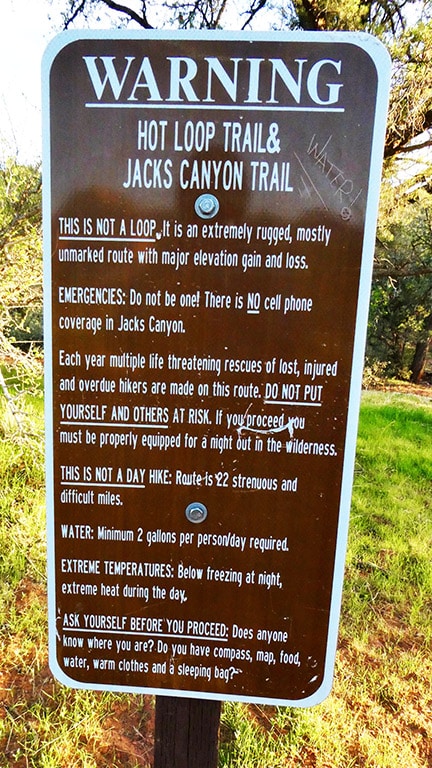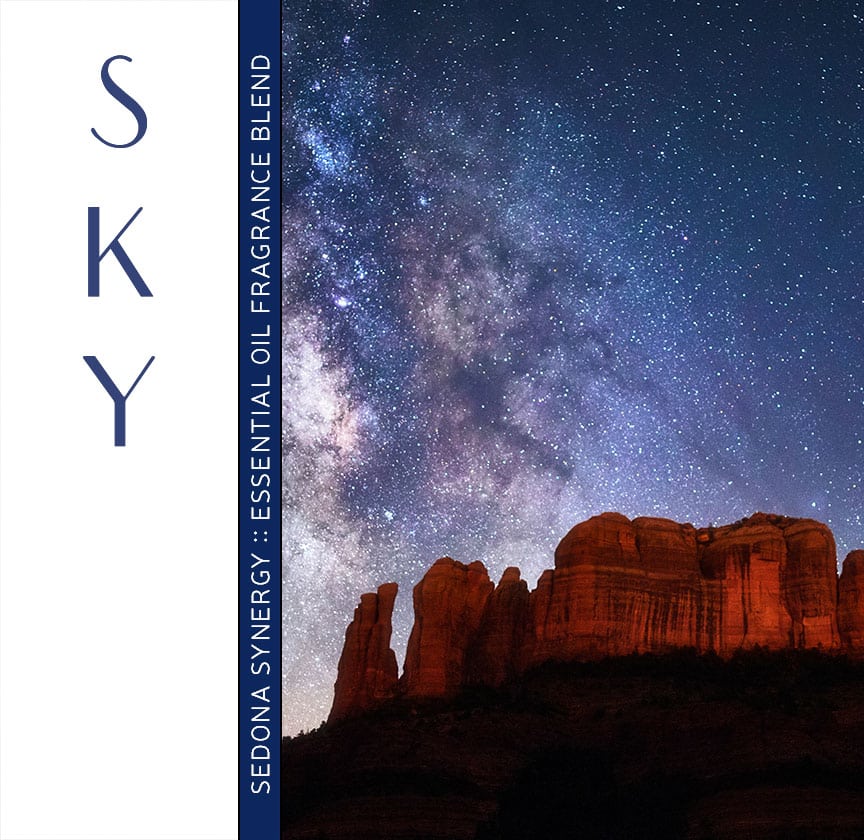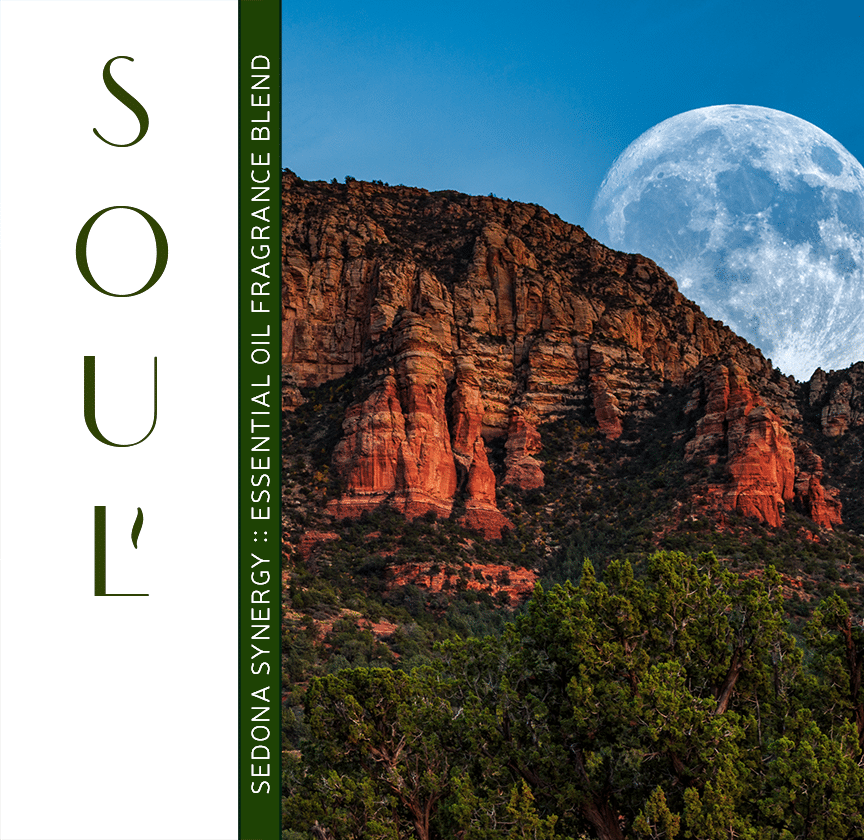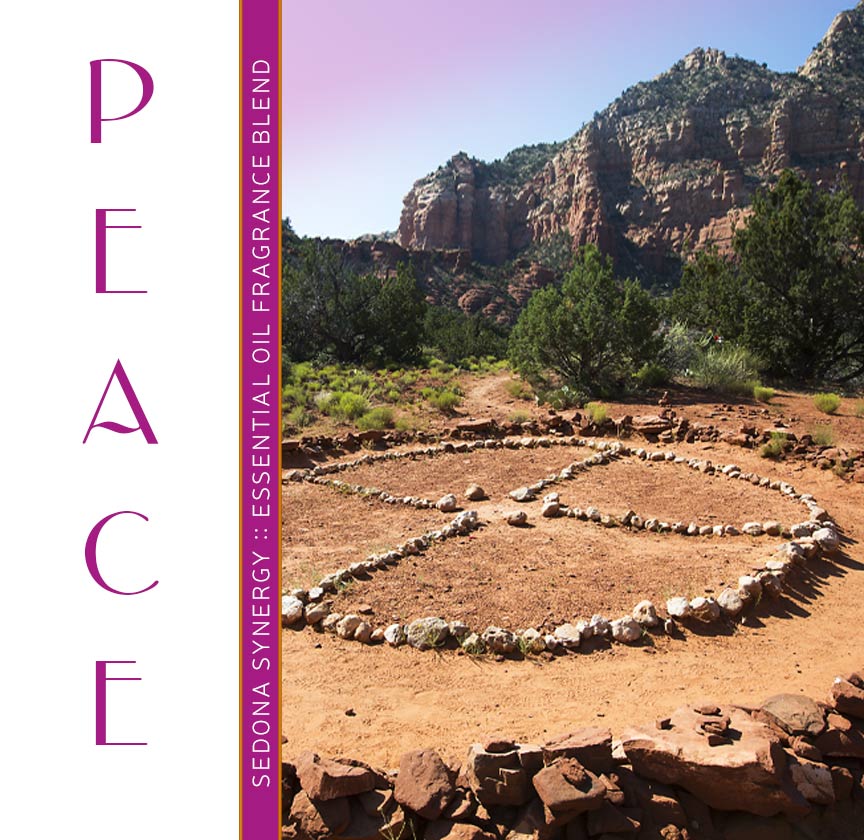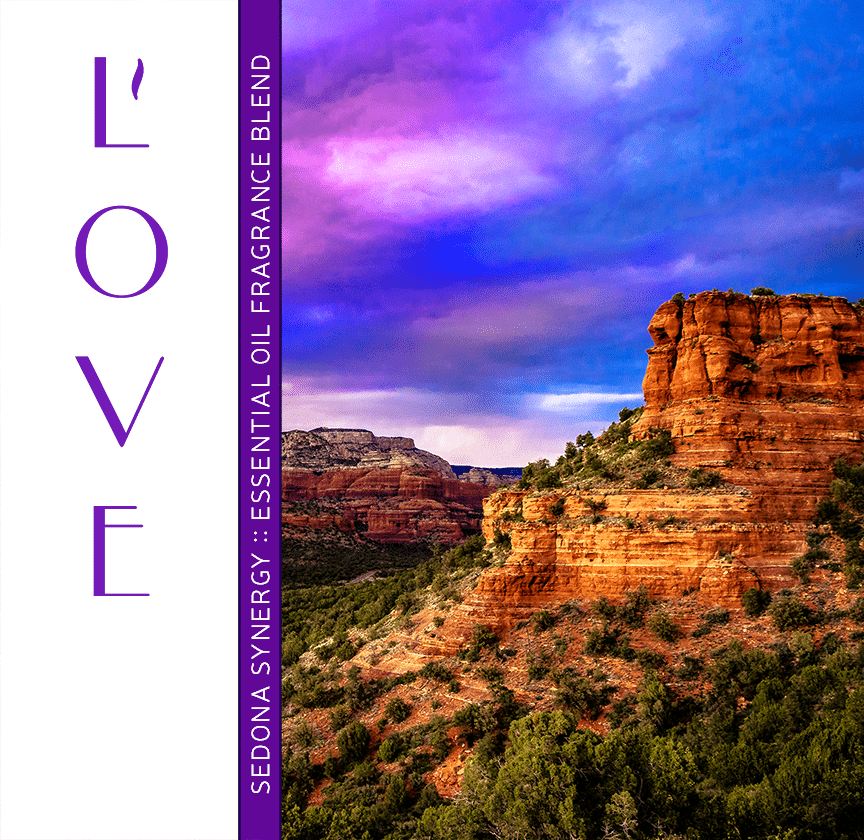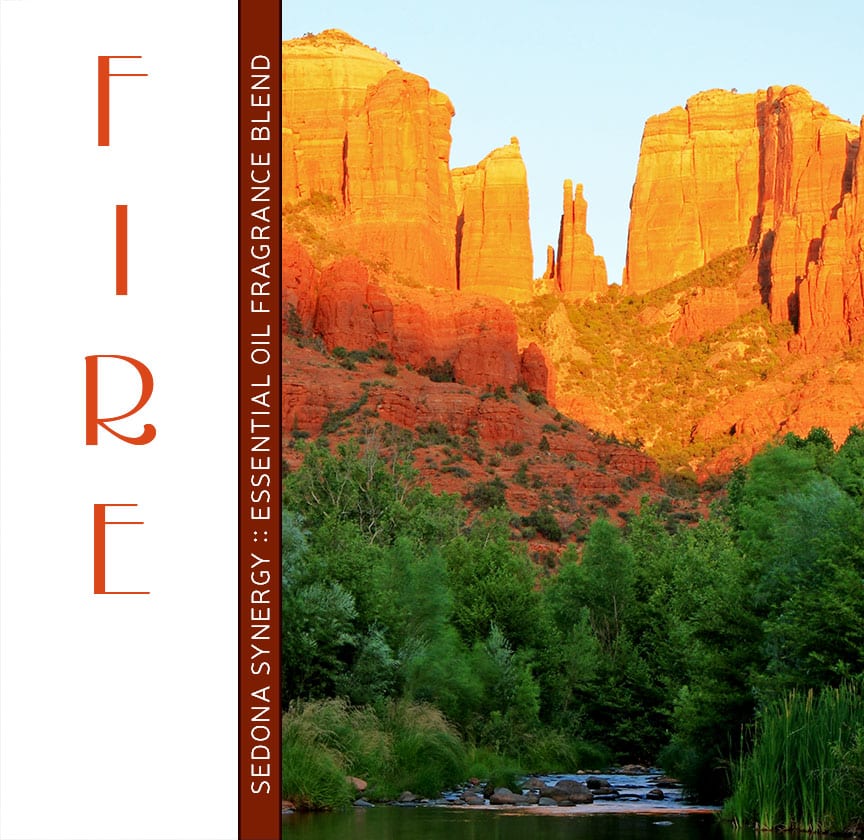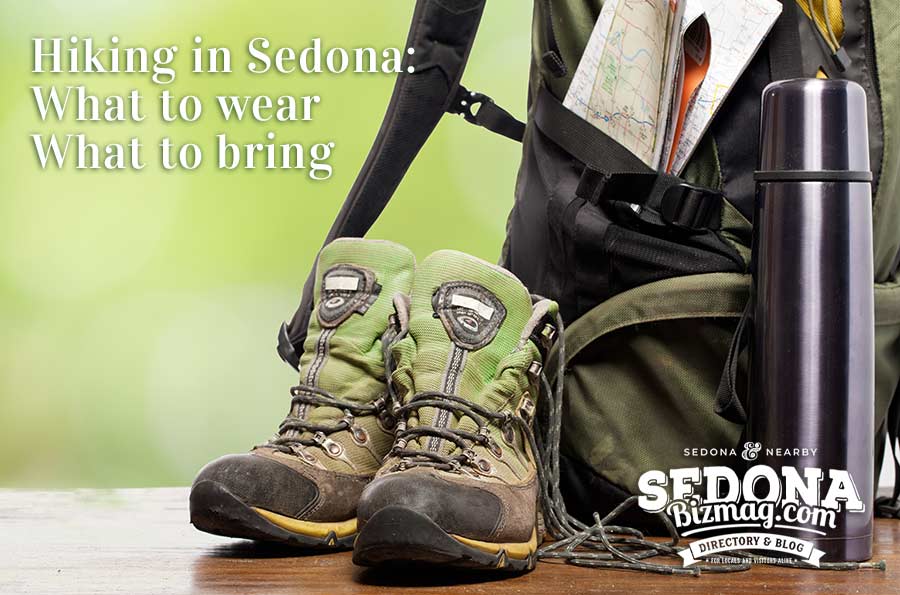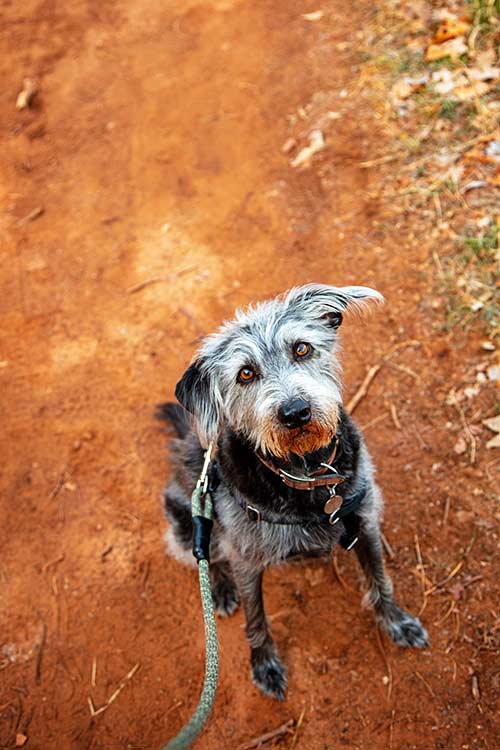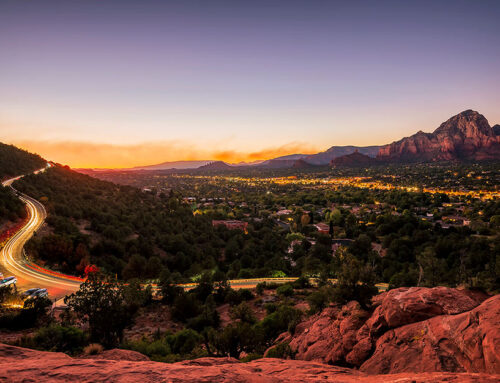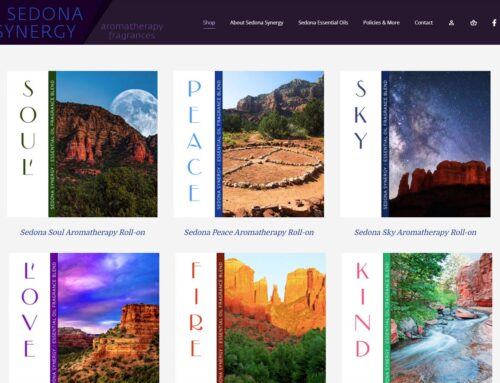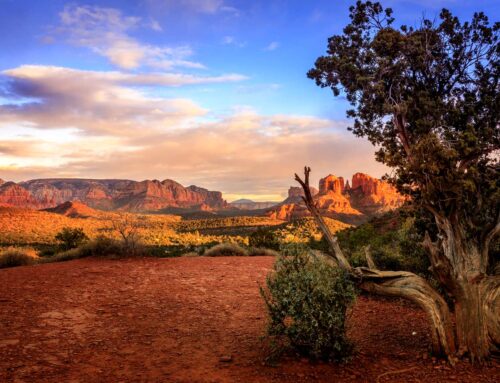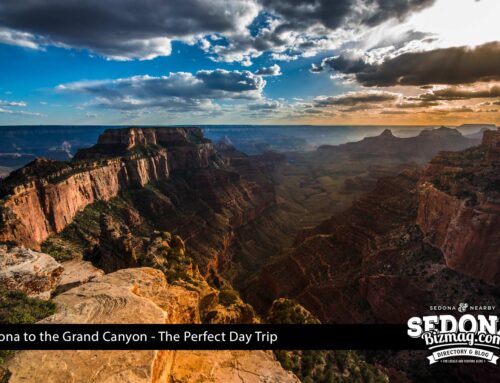Sedona Hiking
Sedona Arizona has over 100 hiking trails and is a popular, global destination for the outdoor enthusiast. Sedona’s unique, red rock landscape guarantees trails that are diverse, beautiful, and accessible year-round. But, it’s not always clear how to choose the right hiking trail for your fitness level and outdoor experience. Not sure where to start? Don’t worry, we’ve got you covered. Let’s take a look at everything you need to know about hiking in Sedona below.
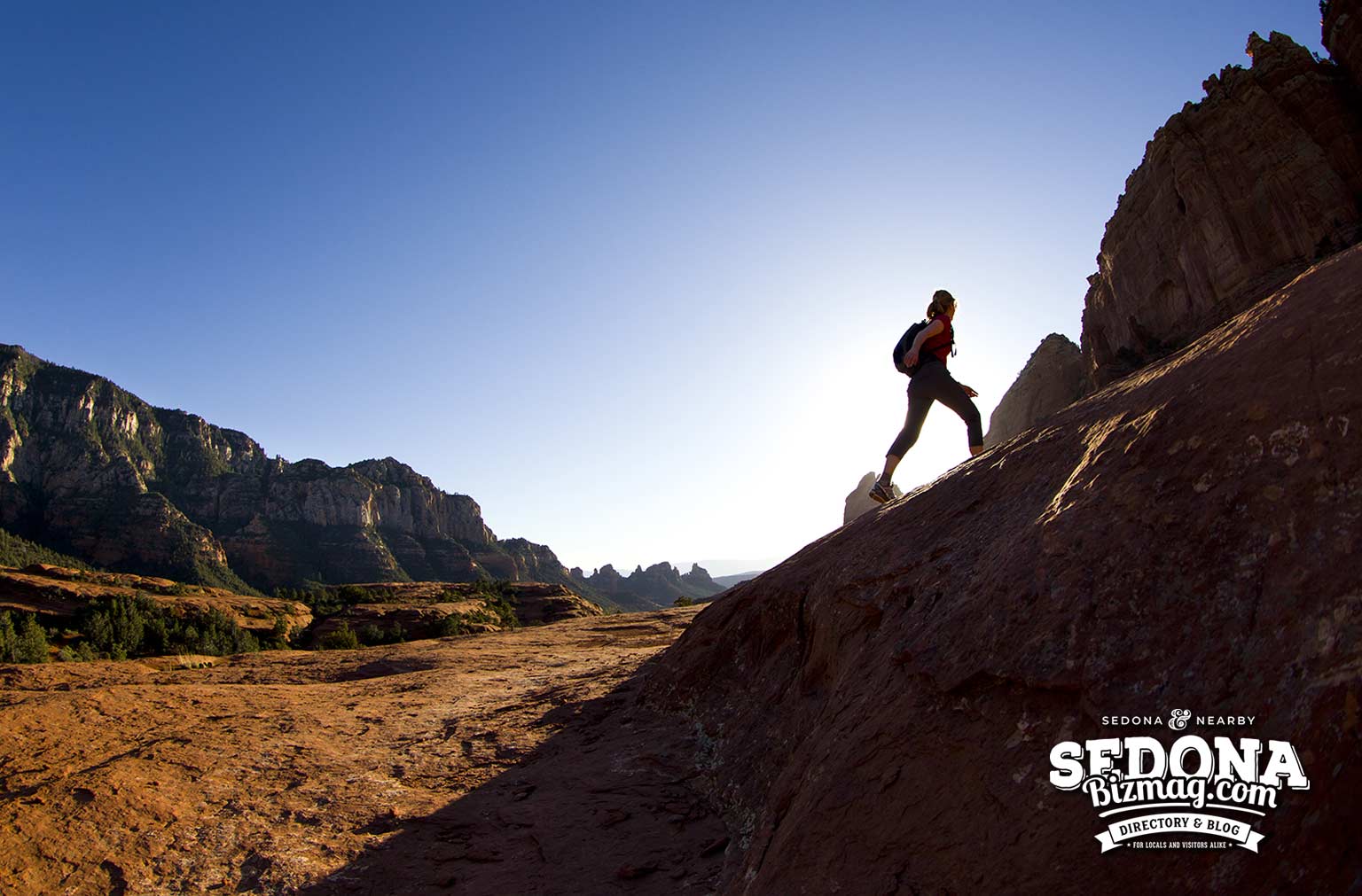
Hiking Trails in Sedona – Route Types (RT)
Out & Back Trails
These trails are one way in and the same way out. You simply turn around at the end of the trail (or somewhere along the path) and hike back along the same trail to the trailhead/parking lot. The length of these trails can be measured one-way or round trip, depending on the source of information.
Loop Trails
These trails loop. You do not typically turn around and return to the trailhead on these kinds of trails, but you end up there eventually in a circular fashion.
Point-to-Point Trails
These trails are usually longer and are not designed as a hike where you return to the original trailhead. These trails require transportation coordination since your hike ends at a completely different location from where you started.
Connecting Trails
Many hiking trails in Sedona connect with other trails. It is important to watch out for these. Have a trail map on hand, so you don’t get turned around or lost.
Trail Length
As you may expect, one of the most important attributes that you’ll need to keep in mind is the length of the trail. Shorter trails are generally more suited toward beginners, even if they have sections that are difficult to overcome.
For example, there’s a big difference between a two-mile trail that has rough terrain and a 10-mile trail, as longer trails can be particularly exhausting for those who haven’t trained their bodies to handle them.
If you’ve never hiked before, it’s best to choose a trail that’s less than two or three miles. This will give you a feel for the experience without being overly taxing.
Of course, there is no rule that says you have to hike the whole distance. Keep in mind the return trip may double your hiking time, at least. For inexperienced hikers, make sure you turn around well before you run out of energy.
Trail Incline
The sharper the trail’s incline is, the more difficult your hike will be. Even a short hike can be thoroughly exhausting if it has a steep incline.
Higher inclines are also slightly more dangerous, as you’ll need to take care not to slip and fall along your journey. If you drop personal items on your hike, you may have to backtrack in order to retrieve them, too.
So, hikers who have less experience should opt for trails that have a lower incline unless they have a high level of physical fitness. Since becoming fatigued while out in the wilderness comes with many other complications, it’s imperative that you only choose trails that you know you can handle.
See Directions to Sedona – Driving to Sedona 9 Different Ways with Maps
Trail Descriptions
Read these signs! Photo by Max Licher
READ: Sedona Wildflowers – Colorful desert blooms along the trails in Red Rock Country
Sedona Weather
Make sure you are prepared for the weather during all seasons. The heat of a summer’s day can significantly affect your stamina and create dangerous health risks while on the trail. Sedona is a high desert. This means wide temperature swings between day and night. Wear layers and plan your hikes at the right time of day. Another very important issue to remember is the dryness. Even in the winter, you can dehydrate quickly. Bring lots of water and drink often during your trek.
READ: Sedona Weather… Always Beautiful
For sunset times, read: Sedona Sunsets – Discover the 7 Best Places in Sedona to Watch the Sunset
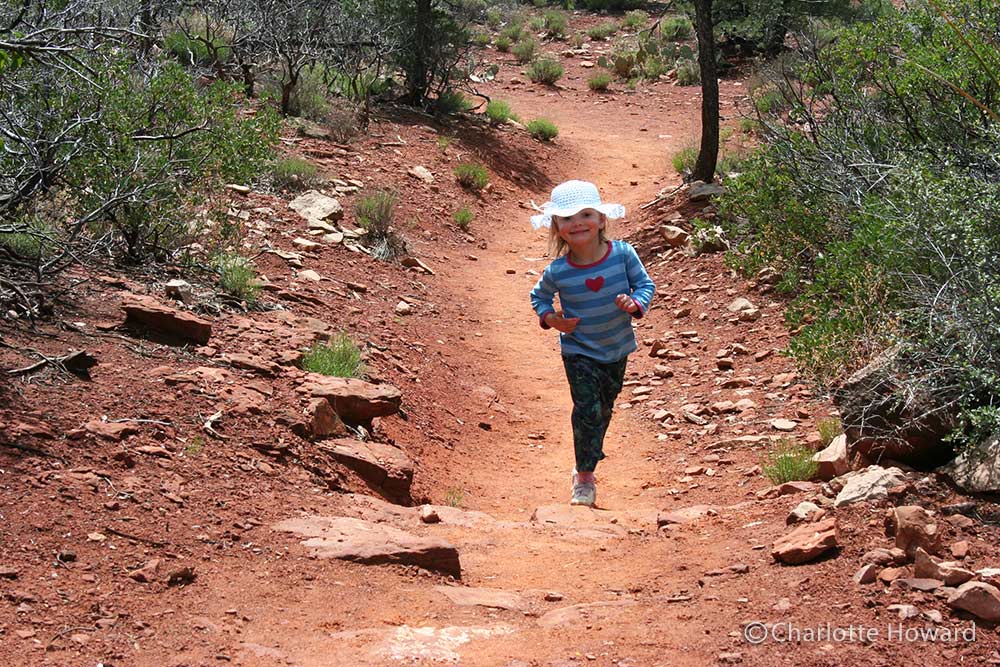
Consider Everyone in Your Hiking Group
Choose your trail based on the least experienced, weakest, adult or child in your group. You want hiking in Sedona to be a pleasant experience for your clan of fellow trekkers. Sedona has trails for all hiking levels and preferences. Choose one that will not lead to disappointments or problems.
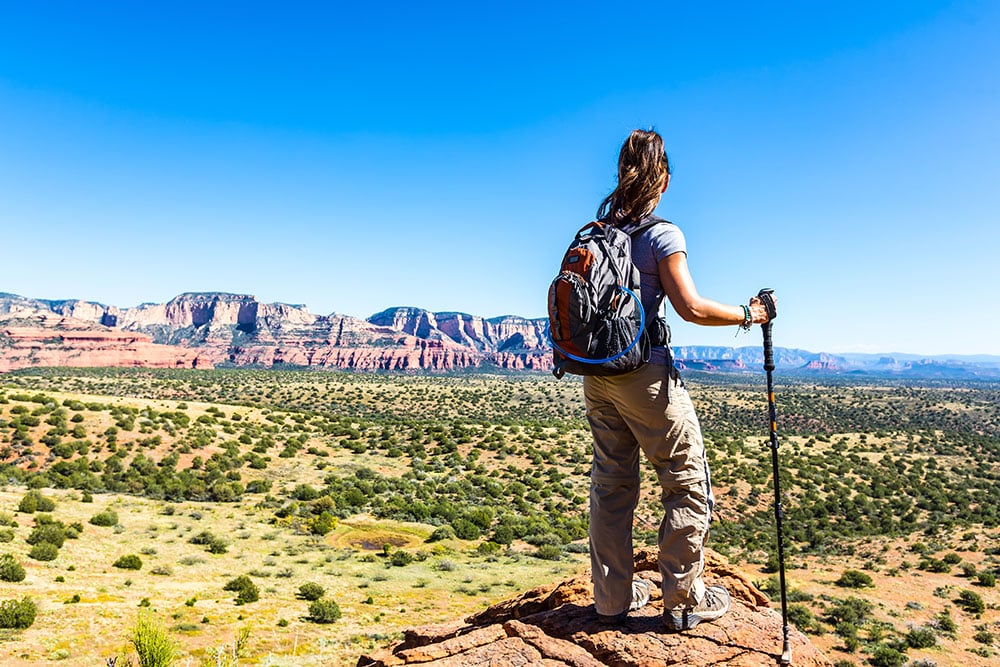
Trail Access & Remoteness
Not every trail is easy to access, even if the trail is relatively easy to hike.
For example, some trails may require you to park a significant distance away from the entrance to the trail. This could require you to walk a fair amount before your hike even begins!
Other trails may require you to navigate difficult roads. Many times, these roads also become dangerous if the weather has recently been unfavorable.
As such, you should only visit trails located in these areas if you’re accompanied by someone experienced with the nuances of the region. Otherwise, you run the risk of property damage, injury, etc.
Fortunately, there are many high-quality hiking trails in the Sedona area that have direct access. So, hikers of all experience levels have plenty to choose from.
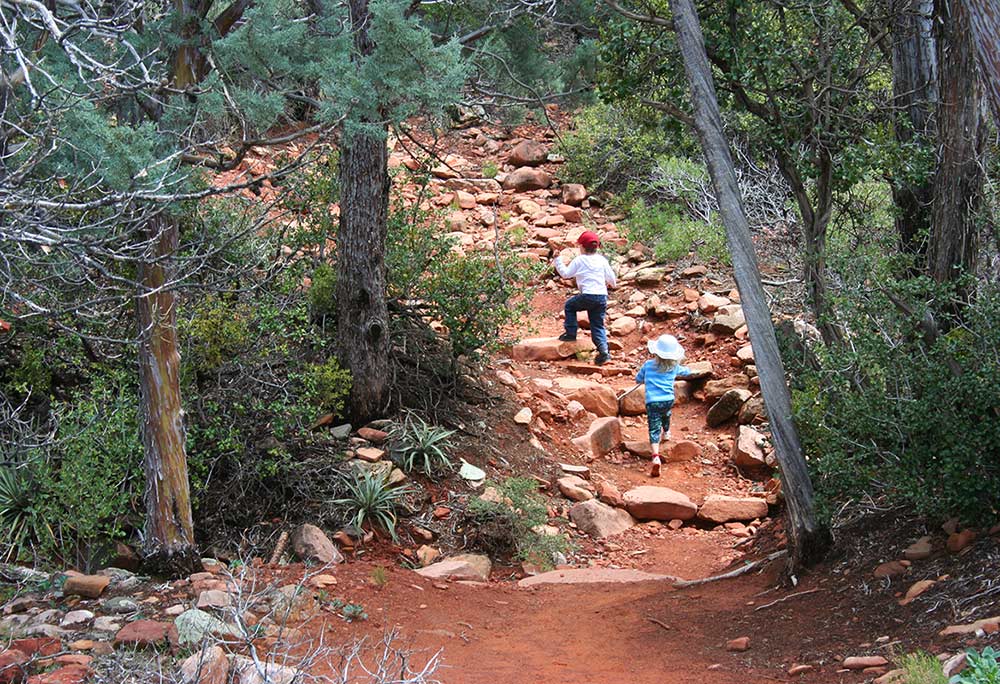
Trail Popularity
When you plan your hike, think about the popularity of the trail and how this fits in with your expectations. Most hikers are happy people. It is fun exchanging smiles and friendly greetings with other hikers enjoying red rock country. It can also be safer if you run into trouble while hiking. A twisted ankle, a snake bite, or forgotten sunscreen can all be helped more quickly on a popular trail. Popular trails in Sedona are a better choice for inexperienced hikers and adventurers.
If you are a seasoned hiker and outdoorsman or woman, you may prefer the solitude of more obscure, remote, or harder trails. Sedona has an amazing variety of trails for every type of hiker.
READ: Enjoy West Fork Trail Sedona with Your Kids
Creeks, Washes, Mud, and Waterfalls
Some Sedona hiking trails lead to water. There are several trails that meander along Oak Creek. West Fork Trail in Oak Creek Canyon crosses the creek multiple times. Some dry creek beds and washes can get muddy during the monsoon season and when the snow melts in the spring. You can even hike to waterfalls on the rare, wet occasion.
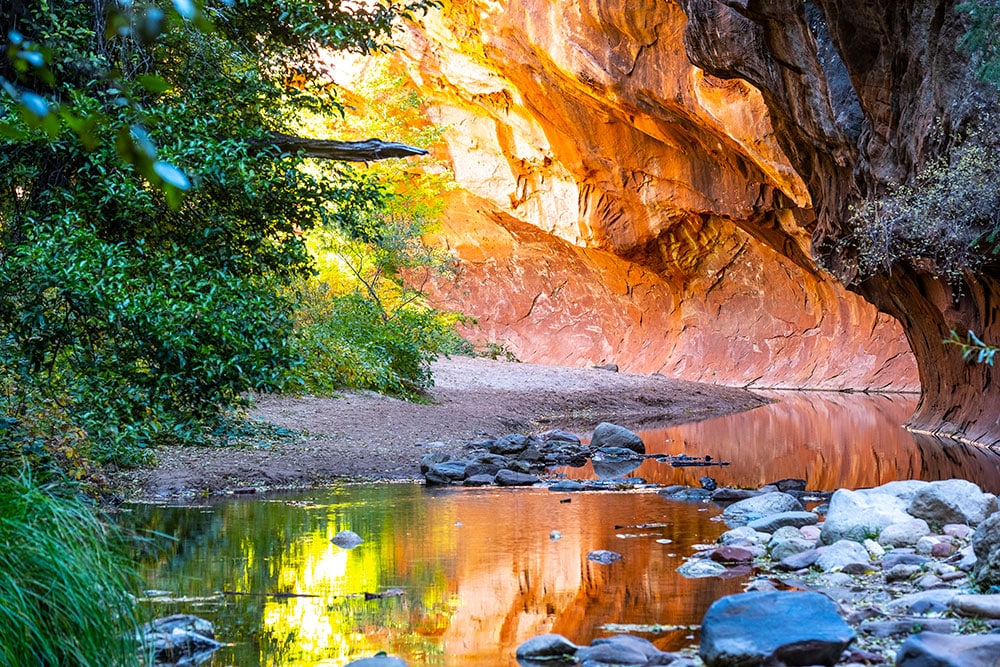
Planning on hiking in Sedona today? Check out the weather ⇓
General Tips for Sedona Hikers
Once you’ve chosen your trail, there’s still a handful of information that you’ll need to keep in mind in order to make your hiking experience as safe and memorable as possible. Fortunately, these tips are easy to implement.
Tell someone where you are
One of the most important steps you should take before going on a hike is letting a friend or family member know where you plan to be. In the event that you become lost, injured, etc., this will make it far easier for you to receive the help you need in a crisis situation.
If you plan on hitting multiple trails in a single day, tell someone when you plan to arrive at the site, what order you’ll tackle the specific trails, and when you plan to return.
This is especially crucial since some of the more remote areas don’t always have a reliable cell phone signal.
Take someone with you
Hiking alone can be notably dangerous. No matter how experienced you are, there’s always the threat of wildlife, getting lost in unfamiliar territory, injuries, etc.
A hiking buddy can make your hike significantly safer. In the event of an emergency, they’ll be able to assist you, call for help, or flag down other hikers. But, hiking with others is also an enjoyable bonding experience that’s worth taking advantage of.
Family-friendly hikes like Bell Rock, WestFork, Crescent Moon, and Slide Rock are great places to start.
READ: Sedona Vortex Hikes – The Beginner’s Guide to a Transformational Experience
Bring food and water for everyone
If you’re only going out for a shorter session, you should still always bring snacks and plenty of water with you. Even if you don’t feel like you’ll need it, having those supplies can mean the difference between a safe, enjoyable hike and one that’s more unpleasant.
For example, you may suddenly feel the effects of dehydration halfway through your hike and be unable to get to safety efficiently. Having food and liquids on hand will help you keep your energy levels high and ensure that you’re able to finish your hike without any issues.
In general, it’s best to take a large bag/backpack that has plenty of room for these necessities.
Plan your hike
Finally, it’s imperative that you plan your hike thoroughly before showing up to the trails. It’s also highly recommended that you don’t attempt to figure things out as you go, as this may result in your getting lost, running out of supplies, etc.
For example, many hikers who don’t plan their trips find that their hikes take them far longer than they anticipated. As a result, they end up lost on the trails well after sundown.
So, plan what time you intend to get there, what trails you’re going to take, when you plan to leave, etc. Additionally, plan time to rest/eat throughout the day so you can stay as healthy as possible.
What to wear and what to pack for hiking in Sedona – Recommendations
- Backpack
- Water
- Food
- Sunscreen
- Insect repellent
- A fully charged cell phone
- A whistle
- A hat
- Trail maps
- Hiking boots or athletic shoes with a good grip
- A camera
- Convertable pants
- Extra pair of socks
- Extra clothing for layers
- A multi-purpose knife
- Tissues and ziplock bags
- Flashlight
- A first aid kit
- A snake bite kit
- A walking stick (optional)
- Friends!
About your 4-legged hiking companions…
Make sure your pet is leashed, for their own safety as well as the safety of other hikers, their pets, and wildlife on the trail. Bring plenty of water for them and treats. Keep an eye on their energy levels and the heat of the day. If your dog is not used to adventuring, their feet may get tender on some of the rockier trails. Remember, they are wearing a fur coat and do not have endless reserves of energy like we sometimes think they do.
Please – pack out your trash!
Hiking in Sedona is free, but parking isn’t.
According to the USDA / Coconino National Forest website:
“A Red Rock Pass is required when leaving your vehicle unattended while recreating on National Forest land around Sedona and Oak Creek Canyon. View the Red Rock Country Map to see locations of fee areas where the Red Rock Pass is required.
“The pass must be displayed in the windshield of the vehicle. Vehicles parked on the National Forest in the red rock area that do not display a valid pass in the windshield are subject to receiving a citation. A pass is not required for incidental stopping to take a photograph or to enjoy a scenic vista (approximately 15 minutes or less).”
Can you take rocks, sand, or dirt from Sedona?
No.
Taking anything from federal, state, or city land is considered an act of vandalism and/or theft.
Don’t move rocks around on trails or in creekbeds.
Don’t build your own cairns.
Do not mark rocks or trees.
Stay on the trails. Don’t forge new ones.
Permits are required to collect plants or plant material.
Take only pictures and leave only footprints.
Pack out your trash.
Thanks! You’re awesome!
Choosing the right hiking trail in Sedona can seem difficult…
But it doesn’t have to be.
With the above information about how to choose the right hiking trail in mind, you’ll be well on your way toward making the decisions that are best for you.
Want to learn more about Sedona hiking trails? Purchase some books and maps before you arrive.
Do you think this article should link to your website?
Promoting Your Business
How do we promote your business? Well, this online magazine is one example. You can choose 4 different ways to utilize this space:
Business Directory Listings
Directory Listings last 1 month, 6 months, or 1 year. They feature your contact information, logo or profile pic, photos, YouTube videos, business descriptions, map, and a link to your website. See a Business Directory Listing Template here ⇒
Read the Sedona Business Directory Resources & Guidelines here ⇒
Ads
Ads are billed monthly, every 6 months, or yearly and have several locations on this website to choose from. See Ad Specs here ⇒
Articles
Articles (blog posts) are a really fun and inexpensive way to get published on the web (and get links!). See our Article Guidelines here ⇒
Homepage Cover News Story
This large, high-visibility section at the top of the homepage is available only 52 times per year and is published for a full week. It is offered on a first-come/first-serve basis. One business can reserve this premium space only twice per month. Read Guidelines here ⇒
Social & Email
Sedona Biz Mag also maintains FaceBook and Instagram pages, as well as an eNewsletter to further share your content across multiple platforms and through email.
View Advertising Services
Subscribe & Get Some Good News!
Special Offers, Opportunities & Information
for Locals and Visitors Alike 😊
We do not spam. You can unsubscribe anytime.

